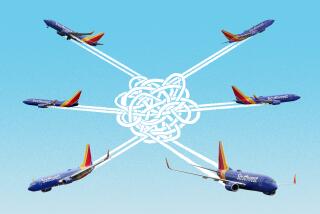ValuJet Crash Takes a Toll on the Airline; Traffic Off 6%
- Share via
ValuJet Airlines, only a month ago the Cinderella of U.S. commercial aviation, is now fighting for its long-term survival in good part because public attention remains fixed on the painfully slow recovery of its plane that crashed in a Florida swamp.
The 2 1/2-year-old carrier, itself providing the first statistical evidence that the May 11 disaster and publicized recovery effort still weigh on other travelers, said Wednesday its passenger traffic in May fell 6% from the same month a year ago.
The grim recovery of the ValuJet DC-9 and the bodies of its 110 passengers in the Everglades “just seems to keep dragging out and that does hurt,” said Raymond Neidl, an analyst with the investment firm Furman Selz Inc. in New York.
ValuJet, an Atlanta-based carrier that has prospered with low costs and cheap fares, also said its planes flew nearly half empty for the month. Its load factor--the percentage of seats filled--tumbled to 52.7% from 71.5%.
ValuJet flies to 31 cities in 19 states, mostly in the East and South. Some decline in its traffic was expected, not only because an airline’s business normally drops after a crash, but also because ValuJet voluntarily slashed half of its service after the accident. The airline halved its daily departures to about 160 in order to check the safety of its remaining 51-plane fleet.
ValuJet’s passenger figures for June and July will give a more precise indication of how the crash has affected the airline, as will ValuJet’s second-quarter financial report, which likely will be announced in July or August.
For now, analysts said the May figures indicate that travelers remain nervous about ValuJet in the face of the continuing publicity surrounding the crash site. The 6% drop came in ValuJet’s revenue-passenger miles, a common industry yardstick that measures the number of paying travelers and how far they fly.
“The fact that it has dragged on and on . . . is complicating matters,” said John Pincavage, an analyst with the New York investment firm Dillon, Read & Co. “Normally when these things happen, it’s usually over quickly.”
Indeed, after their initial shock, airliner crashes almost always fade rapidly from travelers’ minds. The bodies are removed, pieces are picked up for investigation, the story vanishes from the nightly news, and the airline gets on with business.
But in ValuJet’s case, the public has been fed almost daily accounts of divers battling the Everglades’ muck and other hostile elements merely to uncover a few pieces of the DC-9. The cause of the accident has not yet been determined.
With about 70% of the wreckage now recovered, federal officials are winding down their search. Investigators said they may decide as early as today or Friday to stop searching the impact crater for the remainder of the shattered jetliner.
Even so, reports are surfacing that the Federal Aviation Administration had safety concerns about ValuJet months before the crash and therefore might not have executed proper oversight of the carrier. That keeps ValuJet in public view.
“That’s another whole story that’s going to be coming out over the next several months, and the ValuJet name is going to get mentioned over and over,” said Michael Boyd, president of Aviation Systems Research Corp., a consulting firm in Golden, Colo.
“If they closed the crash site today, ValuJet would still be in the news” because of the regulatory questions, “and it’s going to continue to harm them,” he said.
ValuJet spokesman Gregg Kenyon said the airline is confident it will rebuild its passenger traffic in the next few months, especially because “we’re heading into a very strong summer travel period.”
Still, ValuJet’s woes bring to mind two other unique airplane disasters that permanently scarred the public’s psyche toward the now-defunct airlines involved.
One was the crash of an Air Florida jet into the Potomac River near Washington in 1982. With television news cameras covering the drama, bystanders jumped into the frozen river to save surviving passengers as the aircraft’s tail--with the logo Air Florida in plain view--served as a backdrop. Air Florida’s reservations immediately plunged, and the airline was in bankruptcy a few months later.
Then there was the midair explosion of a Pan American Airways 747 over Lockerbie, Scotland, in 1988. Caused by a terrorist bomb, the crash prompted many Americans to avoid overseas travel and helped seal Pan Am’s doom.
But some analysts noted that Air Florida and Pan Am already were weak airlines before the crashes, whereas ValuJet is currently strong financially. ValuJet has about $250 million of cash on hand and a healthy balance sheet, they said.
“With a quarter-billion dollars of cash, ValuJet does not look like a Pan Am situation,” said Steven Lewins, an analyst with the investment firm Gruntal & Co. in New York.
ValuJet also should get a major boost from the Summer Olympics in Atlanta, because the major carrier in that city, Delta Air Lines, “won’t be able to handle it all,” said Dillon Read’s Pincavage.
The Associated Press contributed to this report.
More to Read
Inside the business of entertainment
The Wide Shot brings you news, analysis and insights on everything from streaming wars to production — and what it all means for the future.
You may occasionally receive promotional content from the Los Angeles Times.











